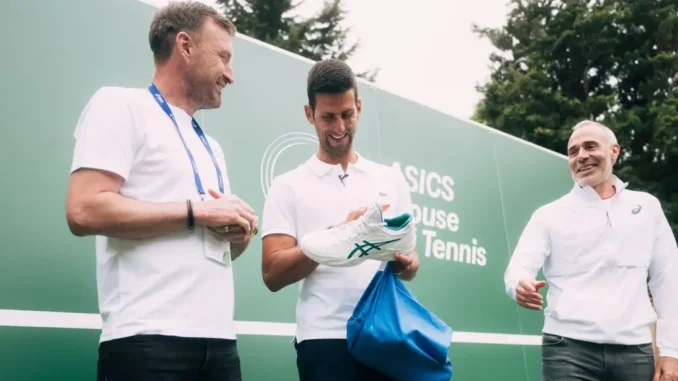
Novak Djokovic, the 24-time Grand Slam champion, has long been celebrated for his meticulous attention to detail, a trait that has propelled him to the pinnacle of tennis. However, this same drive for perfection creates significant challenges for his footwear supplier, ASICS, as revealed by Rene Zandbergen, Senior Manager of CPS Footwear and Innovation at ASICS Europe. Djokovic’s obsessive approach to his tennis shoes, particularly his habit of frequently changing them, has pushed the boundaries of innovation, testing the limits of design and production to meet his exacting standards.
Since partnering with ASICS in 2018, Djokovic has collaborated closely with the brand to develop his signature Court FF Novak series, a line tailored to his unique playing style. Known for his extraordinary movement and trademark sliding on all surfaces, including hard courts, Djokovic demands shoes that balance flexibility, stability, and durability. “I’ve really enjoyed the process. Sometimes not, most of the time, yes. Good things take time,” Djokovic said, reflecting on the painstaking development of the Court FF3 Novak, launched in January 2023. His involvement is hands-on, scrutinizing every detail from outsole geometry to lacing systems, ensuring the shoes enhance his ability to slide, pivot, and recover without compromising ankle support.
Djokovic’s habit of using fresh shoes for nearly every practice and match poses a unique problem for ASICS. “What we see with Novak is he will use shoes for one practice before, so he will move into the match with the shoe. Then we get the shoes back and look at where they have been worn,” Zandbergen explained. This rapid turnover limits the wear data ASICS can collect, as a single match or practice session doesn’t sufficiently stress the shoes to reveal long-term performance insights. This makes it difficult to refine designs, forcing the team to rely on Djokovic’s immediate feedback. “I know I was not easy on the ASICS guys because there was more than a few times that I came up with different models and I didn’t like the small details,” Djokovic admitted, underscoring his relentless pursuit of perfection.
The Serbian’s sliding technique, honed from childhood skiing and playing on uneven surfaces, places extraordinary demands on his footwear. “Since a very young age, I’ve been sliding a lot on all surfaces, even though it’s not by the books, particularly on grass,” he noted. This style, which inspired a generation of players, requires shoes that can withstand intense lateral forces while preventing injuries. ASICS responded with innovations like the TwissTruss technology in the Court FF3 Novak, which splits the outsole into three sections for enhanced flexibility and shock absorption, reducing bodily stress by 7%. A new shoe, set for release in January 2026, will feature covered laces to prevent wear from sliding, addressing a specific issue where players burn through laces on hard courts.
Djokovic’s perfectionism extends beyond functionality to symbolism. His shoes bear personal touches, such as a Reiki symbol for universal energy, a dove representing peace and his admiration for Nikola Tesla, and the number “24” on the heel, commemorating his Grand Slam titles. “Everything matters about how you feel on a tennis court,” he emphasized, highlighting the psychological and physical importance of his footwear. These customizations, while available to consumers, reflect his deep involvement in the design process, which began with eight prototypes for the Court FF3 Novak to perfect flexibility and stability.
The challenge of keeping up with Djokovic’s demands is compounded by his packed schedule, making it hard to secure time for feedback sessions. During the COVID-19 pandemic, virtual meetings allowed Zandbergen to build a stronger rapport with Djokovic, but in-person sessions remain critical. “I would sit with him on the bench during the session and get some feedback on what he liked from the shoes we had given him and what we could change,” Zandbergen shared. This iterative process, involving multiple prototypes tested as early as January 2021, underscores ASICS’ commitment to meeting Djokovic’s needs while advancing technology for all players.
Despite the difficulties, Djokovic’s partnership with ASICS has been fruitful, producing a shoe that blends the stability of the Gel-Resolution line with the speed of the Solution Speed series. “It’s like jumping into a sports car,” Djokovic said, praising the Court FF3 Novak’s lightweight feel and responsiveness. His influence ensures that retail versions are nearly identical to his own, benefiting club players worldwide. However, his frequent shoe changes and high expectations continue to push ASICS to innovate relentlessly, mirroring Djokovic’s own pursuit of excellence on the court.
As Djokovic, now 38, prepares for the 2026 season, his collaboration with ASICS remains a cornerstone of his success. With a 2025 record of 29-7 and a withdrawal from the Canadian Open due to fatigue, his focus on equipment optimization signals his intent to chase a record-breaking 25th Grand Slam. For ASICS, the challenge of satisfying Djokovic’s demands is both a privilege and a test, as they strive to craft footwear that keeps pace with one of tennis’s greatest movers.
Leave a Reply